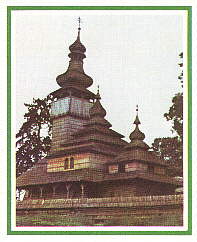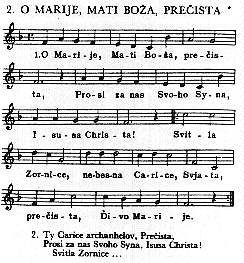
Spiritual Songs
According to
The Carpatho-Rusyn Tradition

Typical Carpathian Wooden Church of Shelestovo, built in 1777. Now preserved in outdoor Ethnographic Museum in Uzhhorod.
The Rusyn people under the Carpathian Mountains besides their own liturgical chant developed another kind of religious singing, known as the Spiritual Songs. These devotional songs, by their simplicity and musical freshness, captivated the hearts of the people and were kept alive throughout the centuries mostly by oral tradition. Today they are considered a treasured part of our Rusyn spiritual heritage.
The Rusyns, by their very nature, are fond of singing. Inspired by the beauty and splendor of their Byzantine Rite, they started to compose their own religious songs to satisfy their spiritual needs outside of Liturgical services - occasions such as processions and pilgrimages - but especially for the seasons of Christmas, Lent and Easter. These were the "Holy Seasons" and the people would not profane them by ordinary folk songs even in their private life.
The first religious songs came to Subcarpathia from the Rusyn Metropolitan Province of Kiev, via Galicia, in the second half of the 17th century. Many of these songs had to be adapted to local circumstances and, consequently acquired a new local melody. But soon our ancestors started to compose their own religious songs. Today, it is almost impossible to determine who were their composers since most of them came to us anonymously. Father Uriel in the Preface of his "Pisennik," published in 1902, stated: "Many of our spiritual songs were composed by simple people, but the majority by the priests, the cantors and, especially, to the monks."
The oldest religious song composed in Subcarpathia is the Song About the Icon of Klokochovo, written about 1683. It is dedicated to the miraculous icon of the Blessed Virgin Mary in the village church of Klokochovo, at that time in the Eparchy of Mukachevo, which in 1670 miraculously shed tears. Another spiritual composition from the same period of time is the penitential song, Song of Sinful People (preserved in a handwritten collection - Kliuch, discovered in Uglya, Tiachevo Co.). Today, it is considered as a "valuable contribution to the early (Rusyn) poetical literature."
With time, the number of the original spiritual songs of Subcarpathia constantly increased, as the numerous handwritten collections from the 18th and 19th century, called "Spivanniki," testify.
The great boost to the composition of religious songs was given by pilgrimages which in Subcarpathia, started with the 18th century, became very popular. For our ancestors these pilgrimages became schools of their spiritual formation, where they strengthened their faith, renewed their lives and nurtured their genuine piety and devotion.
Walking in procession to distant places of pilgrimage, making all-night vigils at the sanctuary or waiting for the next service to start, the pilgrims used to interrupt their prayers with religious songs. One group of pilgrims would start a song, then another, and still another. In this manner they were even able to learn new songs. Soon the entire multitude of pilgrims joined in singing the new songs which they eventually took back to their own villages. In this way many religious songs were spread throughout the entire Carpathian region.
The majority of the original spiritual songs were composed in honor of the B.V.M, inspired by Her repeated miracles in Klokochovo (1670), later in Mariapovch (1696, 1715 and 1905) and, finally, at the Basilian monastery in Krasnyj Brod (1759).
These supernatural interventions of the Most Holy Mother of God convinced our ancestors that Mary did care about them and that in their needs, She was always ready to assist them. These spiritual songs sustained the piety and devotion of the Rusyn people throughout the centuries, and especially during the difficult days of their earthly pilgrimage.
The Marian songs, composed with sincere faith and piety, represent the best of our spiritual compositions and are rightly considered the gems of Rusyn spiritual heritage. Even the Soviet atheist critics are forced to admit that the Subcarpathian Marian songs "enriched by numerous poetical figures and choicest epithets, metaphors and comparisons" reach a "high degree of poetical art" (Prof. O. Myshanych, p 106).
Many songs in honor of various Saints also originated in the Carpathian region. Most of those were composed in honor of the Patron Saints chosen for their churches like St. John the Baptist, St. George, St. Michael, St. Demetrius, St. Parascevea, St. Barbara, etc. But the most popular of these was the song in honor of St. Nicholas, O kto, kto Nikolaja l'ubit', composed in Carpathian land in the 17th century. It was soon accepted and became popular in neighboring Galicia, too.
There are also many original carols and Lenten hymns composed by our ancestors some two hundred years ago. Among those should be mentioned penitential and catechetical compositions about the last things of man: death, judgement, heaven and hell. They were very popular among our people, especially during the season of Lent.
The spiritual songs were spread mostly by the living word and, eventually, were collected by lovers of popular songs. Thus in the Carpathian region we can find many hand-written collections of religious songs, popularly called "Spivanniki" (Hymnals). So far 33 of these hymnals were discovered and studied, mostly from the 18th and 19th centuries. The oldest such "Spivannik" is that of Kamionka, in the Spish district, collected in 1734.
The local copyists of "Spivanniki" were the cantors who collected many of these popular religious songs for practical use. Some cantors had special training in penmanship and provided the richer parishes with artistic copies of their collections. Among these, those of cantor John Yuhasevich (1741-1814), who studied art at the Academy of L'viv, should be singled out. Until now at least five artistic Spivannik-s of Yuhasevich were found. Some of his songs he copied with their proper melody.
At the end of the 19th century some of the most popular spiritual songs were printed as a supplement to the prayerbooks. But the first complete collection of the Rusyn religious hymns was printed in 1902 by Father John Slivay, known in our literature as Father Uriel. Having at his disposition some of the better collections of these songs (for example, those collected by Fr. E. Stripsky, Cantor G. Yacina, Prof. B. Lipecky), and including his own collection, Father Uriel compiled and printed the first Rusyn hymnal-book, entitled, "Pisennik ili Sobranije Pisnej." The songs of Fr. Uriel's collection are of valuable quality but, to quote Father Uriel, they are "precious, since they are our own."
Many of the Rusyn original religious songs were disappearing. Some of them were remembered only by the older people. Others were still sung but only in some far off villages. It often happened that the old, original melody was substituted by some recent but less inspiring tune. There was a dire need to fix the melodies of these songs. For this reason the Redemptorist Fathers of Michalovci tried to publish some songs with the music, first in 1932, and later in 1944. However, both their publications were neither complete nor original.
Only after World War II, a dedicated priest of the Mukachevo eparchy, Re, Stephen Papp, started a tedious and demanding work of collecting our ancient and more beautiful spiritual songs with their original melodies. In 1969, under the patronage of the Prjashev Ordinate, the first original collection of the Rusyn religious songs, with proper music, was published under the title: "Greko-katolic'ki Duchovyni Pisnyi" (Greek Catholic Spiritual Songs). In this hymnal Father Papp collected 178 spiritual songs with their proper music, fifty of which had never been printed before. In the introduction to his publication Father Papp writes:
"The spiritual songs served our Rusyn people as inspiring prayers. Making some necessary corrections to their lyrics, I tried, therefore, to preserve their original meaning and freshness. Those who are acquainted with the Latin-Rite hymns, which were composed by world-wide famous poets and musicians, are pleasantly impressed by the freshness and beauty of our spiritual songs, composed mostly by simple people, and often without any professional guidance. They were inspired by burning love of God, to Whom our people offered these musical gems as an expression of their gratitude."
These "spiritual gems" of the Carpathian region were brought by our ancestors to their adopted country, to the United States. They still fill our Byzantine Rite churches with their freshness and inspiring melodies. But their apotheosis takes place annually on Mt. St. Macrina in Uniontown, Pennsylvania during the Labor Day Pilgrimage in honor of Our Lady of Perpetual Help, under the auspices of the Basilian Sisters. Needless to say, that after listening even for a short time to those spiritual songs, one cannot remain indifferent.
Indeed, refreshing and beautiful are our Rusyn spiritual songs!

*An extract from "Greko-kalolic'ki Duchovyni Pisnyi" of Rev. Stephen Papp.
Byzantine Leaflet Series, No. 28
With Ecclesiastical Approval, May 1983
Byzantine Seminary Press
Pittsburgh, Pa. 15214
Back to Carpatho-Rusyn Spirituality Index